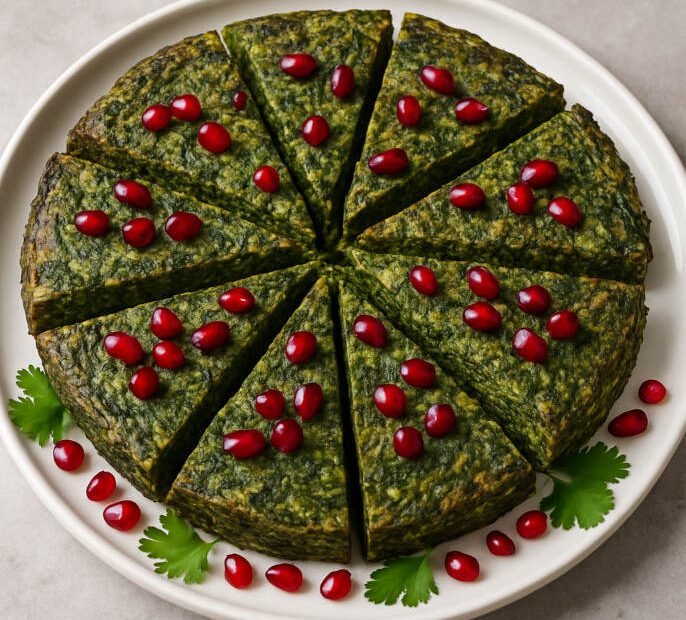Kuku Sabzi is a vibrant Persian herb frittata, packed with fresh greens and aromatic spices. This savory dish, often enjoyed during Nowruz (Persian New Year), combines eggs, herbs like parsley, cilantro, and dill, and a touch of turmeric for a golden hue. Perfect as a light meal, appetizer, or side, it’s crispy on the outside, tender inside, and bursting with flavor. Below, We have a step-by-step recipe to create this delicious dish at home,with tips to ensure success.
Ingredients (Serves 4-6)
- Fresh herbs:
- 2 cups fresh parsley, finely chopped (stems removed)
- 1 cup fresh cilantro, finely chopped
- 1 cup fresh dill, finely chopped
- ½ cup fresh chives or green onions, finely chopped
- 2 tablespoons fresh fenugreek leaves (optional, or 1 teaspoon dried)
- Eggs: 6 large
- Dried barberries: 2 tablespoons (optional, for tangy flavor)
- Walnuts: ¼ cup, finely chopped (optional, for crunch)
- Flour: 1 tablespoon (or chickpea flour for gluten-free)
- Baking powder: ½ teaspoon
- Spices:
- ½ teaspoon ground turmeric
- ½ teaspoon salt (adjust to taste)
- ¼ teaspoon black pepper
- Olive oil or vegetable oil: 3-4 tablespoons
- Greek yogurt or labneh: For serving (optional)
Equipment Needed
- Large mixing bowl
- Whisk or fork
- 10-inch non-stick skillet with lid
- Spatula
- Cutting board and knife
- Measuring cups and spoons
- Optional: food processor for chopping herbs
Step-by-Step Instructions
Step 1: Prepare the Fresh Herbs
The heart of Kuku Sabzi is its herbs, so take time to prep them properly. Wash the parsley, cilantro, dill, chives, and fenugreek (if using) thoroughly to remove dirt. Pat dry with a clean kitchen towel or use a salad spinner. Remove tough stems, keeping only the tender leaves and soft stems. Finely chop by hand or pulse in a food processor until finely minced but not mushy. You want about 4½ cups of chopped herbs total. Set aside in a large mixing bowl.
Tip: The herbs should dominate the dish, so don’t skimp! Chopping them finely ensures even distribution in the frittata.
Step 2: Soak and Prep Barberries (Optional)
If using barberries, rinse them in cold water to remove dust. Soak in warm water for 10 minutes, then drain and pat dry. This softens their texture and enhances their tangy flavor. Set aside.
Step 3: Whisk the Eggs
In a separate bowl, crack 6 large eggs and whisk until fully combined. Add the flour, baking powder, turmeric, salt, and black pepper. Whisk until smooth. The flour and baking powder give the kuku a slight lift, making it fluffier.
Tip: For a denser texture, skip the baking powder. For gluten-free, use chickpea flour—it adds a subtle nutty flavor.
Step 4: Combine Ingredients
Pour the egg mixture into the bowl with the chopped herbs. Add the barberries and chopped walnuts (if using). Gently fold everything together with a spatula until the herbs are evenly coated. The mixture should look green and herb-heavy, with just enough egg to bind it.
Pro Tip: If the mixture seems too wet, add a teaspoon more flour. If too dry, crack in an extra egg.
Step 5: Heat the Skillet
Place a 10-inch non-stick skillet over medium heat. Add 3 tablespoons of olive or vegetable oil and let it heat until shimmering but not smoking. Swirl the oil to coat the bottom and sides of the pan.
Step 6: Cook the Kuku
Pour the herb-egg mixture into the hot skillet, spreading it evenly with a spatula. Gently shake the pan to settle the mixture. Reduce the heat to medium-low, cover with a lid, and cook for 8-10 minutes, or until the edges are set and the top is slightly firm but still a bit soft.
Tip: Low heat prevents the bottom from burning while allowing the kuku to cook through evenly.
Step 7: Flip the Kuku
Here’s the tricky part—flipping! Run a spatula around the edges to loosen the kuku. Place a large, flat plate or cutting board over the skillet. Carefully flip the skillet so the kuku lands on the plate, cooked side up. Add 1 more tablespoon of oil to the skillet, then slide the kuku back in, uncooked side down. Cook uncovered for 5-7 minutes, until golden and fully set.
Alternative: If flipping feels daunting, finish cooking the kuku in a preheated 350°F oven for 10-12 minutes instead of flipping.
Step 8: Serve and Enjoy
Slide the kuku onto a serving platter and let it cool for 5 minutes. Cut into wedges like a pie. Serve warm or at room temperature with a dollop of Greek yogurt or labneh on the side for creaminess. Kuku Sabzi pairs beautifully with flatbread, a simple salad, or as part of a mezze spread.
Serving Tip: Garnish with extra barberries or a sprinkle of chopped herbs for a pop of color.
Tips for Success
- Herb Ratio: The herbs should outshine the eggs. If you’re short on one herb, substitute with more of another, but keep the total volume consistent.
- Make Ahead: Kuku Sabzi tastes great the next day. Store in an airtight container in the fridge for up to 3 days. Reheat gently or serve cold.
- Freezing: Wrap cooled kuku tightly in plastic wrap and freeze for up to 1 month. Thaw in the fridge before reheating.
- Variations: Add spinach or leeks for extra greens, or skip barberries and walnuts for a simpler version.
Why You’ll Love Kuku Sabzi
This dish is a celebration of fresh ingredients and bold flavors. Its versatility makes it ideal for breakfast, lunch, or dinner, and its make-ahead nature suits busy schedules. Whether you’re new to Persian cuisine or a seasoned fan, Kuku Sabzi’s herbaceous, slightly crispy goodness will win you over.
So, grab your herbs and skillet, and let’s make this Persian classic! Have you tried Kuku Sabzi before, or is this your first time? Share your thoughts or tweaks in the comments—I’d love to hear how it turns out for you!
